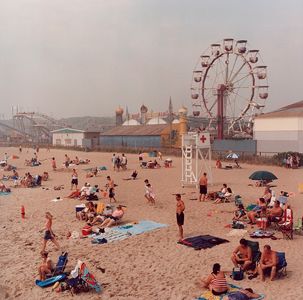BIO

Marla Sweeney has an MFA in Photography from the State University of New York at New Paltz. She also completed the Master’s Class in Photography with Stephen Shore and Larry Fink. Her work has been exhibited widely including solo exhibitions at Yossi Milo Gallery in New York City; Galleri Image in Arhus, Denmark; Fotofest, Houston, Texas; and Encontros da Imagem in Braga, Portugal. Portfolios of her work have been published in Zoom, Camera Austria, and Fotomagazin. Her work is included in several permanent collections including the George Eastman House Photography Collection, Rochester, NY; the Museum of Fine Arts, Houston, TX; and the Harry Ransom Center Photography Collection, University of Texas. Austin, TX. Her commercial clients include Boston Magazine, New York Magazine, Teen Vogue, Getty Images and Millennium Images.
Links:
https://www.lightwork.org/archive/marla-sweeney/
Essays

Marla Sweeney’s work deals with the most interesting, the most important, the most thrilling - but also the most difficult subject in photography: the human portrait. Quoting August Sander would go-perhaps-a little bit too far. But anyway in this tradition Marla Sweeney in her series is not only interested in the more or less beautiful, young, old, shy or happy faces of her fellow citizens. There is a strong psychological and more asocial interest in her approach which also gives her pictures that very interesting conceptual aspect. There is no doubt: Marla treats her subjects with respect and a deep human interest. But that does not prevent her from introducing this sort of subtle irony which is so difficult to obtain. Her pictures- by the way perfectly composed– furnish us with a lot of information about how people in rural America live their daily lives. Standing in the great tradition of American documentary photography from Walker Evans to William Eggleston, Marla Sweeney has developed her very own visual language, using the medium of color photography in the height of contemporary art.
Hans-Micheal Koetzle, 2002
Editor of Leica World Magazine, exhibition curator and book editor
In 2005 I bought a photograph by Marla Sweeney at an auction associated with the Rhubarb-Rhubarb Festival in Birmingham, UK. It was called "Boy Elvis, " and I bought it because it made me laugh. Since then, the image has been touring the country in the "American Faces" section of a major survey of the George Eastman House collection. I included the photograph in the exhibition because it represented a number of current practices in photography—and because it made me laugh. "Boy Elvis" shows a plump and awkward boy in the ridiculous costume of an Elvis impersonator circa 1978. This straightforward portrait shows a clear eye for the telling and significant details of American life, offering insights into an individual character as well as the society he inhabits. It uses color, both to attract the eye and to flesh out an identity.
There is a curious irony in my discovery of Sweeney in the British Midlands, because her true territory is the same as mine. We both grew up in Boston, and we know the beaches of Northern New England with the same bittersweet affection. We know them for their brash happy tackiness as well as their icy gray waters. Proust's madeleine for us would be fried clams with the bellies on, washed down with a can of tonic.
Sweeney's beach portraits feel like truth to me. Their subjects are not the self-conscious toned beauties of such places as South Beach or Santa Monica. Sweeney shoots the old, the poor, and the imperfect, yet despite the vulnerability of the half-dressed before the gaze of a stranger, they have dignity, strength, and self-possession. An image of an old woman in a voluminous flowered bathing suit and rubber cap shows veined thighs and sagging skin, but she faces the camera with comfort and confidence. We feel that she has come to the ocean often, that she is happy by the sea, and even that she has grown wise there. Another image shows a mother and son, both sheltered under a huge umbrella, the son sheltered additionally by his mother's protective embrace around his narrow shoulders. We also see the emphasis on relationships in a photograph of two young boys. We know they are brothers by the title, but we would intuit it from their resemblance and their easy, mirroring stances. They are not conventionally appealing children. Their pale skin and hollow rib-revealing torsos suggest some level of deprivation, but they are happy and safe at the beach with their cups of slush and each other. Sweeney's image of a freckled, almost adolescent boy wrapped in a striped towel is as sweet as "Boy Elvis." Like her other subjects, the boy is willing to be photographed. He participates in the picture making with his solid stance and his red, white, and blue presence, echoed by a glimpse of an American flag flying above the otherwise fog gray environment.
Portraits fall into two distinct categories. First there are the images of the already famous that serve visually to explicate and reveal personalities we think we already know. Think of Arnold Newman's portrait of Truman, Avedon's joint chiefs of staff, or almost anything by Annie Leibovitz. The second category takes the unknown and turns them into icons. In this group, we have Walker Evans's searing images of "Let Us Now Praise Famous Men, " Dorothea Lange's "Migrant Mother, " or most photographs by Robert Frank. We respond to the first kind of portraits for the specific information that enhances knowledge we already have. However, it is, I think, the second kind that resonates. Photographs of strangers give us the only information we have about them. Indifference, shyness, or good manners might keep us from looking at, or even noticing, these people if we crossed paths in our real lives. Photographs give us permission to look long and wonderingly, and, of course, to see ourselves.
Alison Devine Nordstrom, 2008
Curator of Photographs at George Eastman House International Museum of Photography and Film, Rochester, NY
